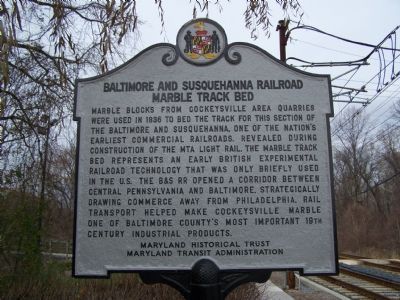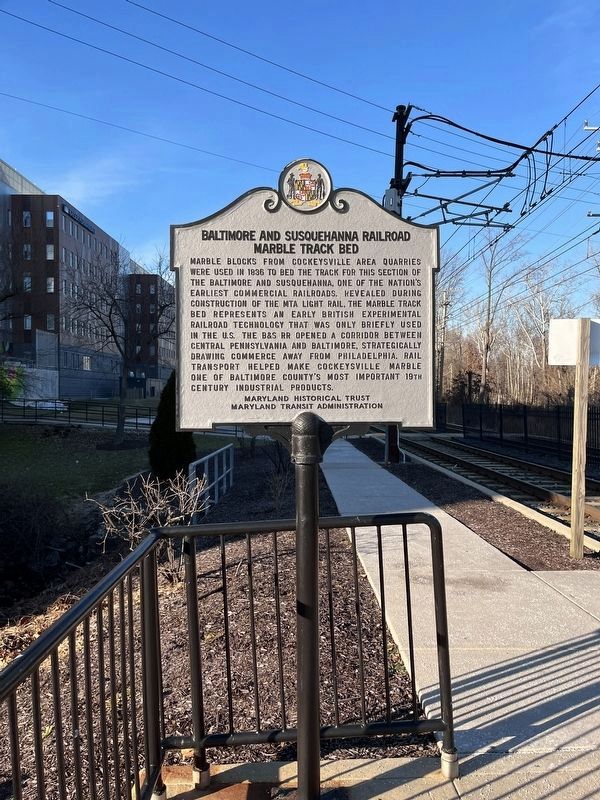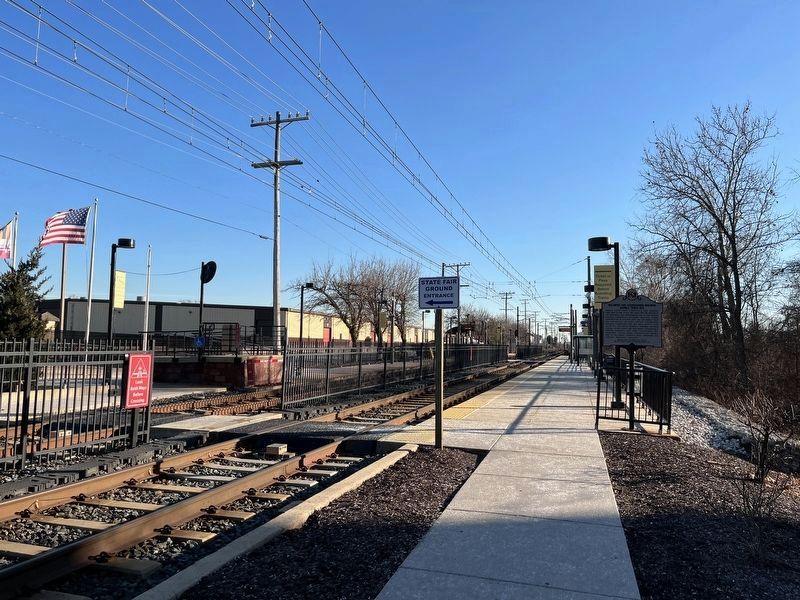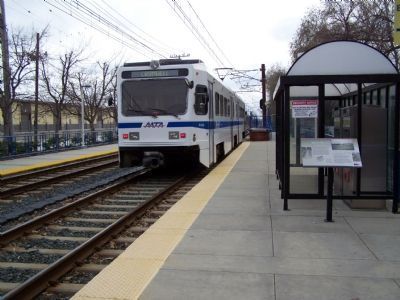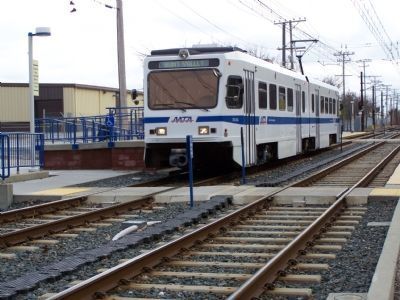Timonium in Baltimore County, Maryland — The American Northeast (Mid-Atlantic)
Baltimore and Susquehanna Railroad Marble Track Bed
Inscription.
Marble blocks from Cockeysville area quarries were used in 1836 to bed the track for this section of the Baltimore and Susquehanna, one of the nation's earliest commercial railroads. Revealed during construction of the MTA Light Rail, the marble track bed represents an early British experimental railroad technology that was only briefly used in the U. S. The B&S RR opened a corridor between central Pennsylvania and Baltimore, strategically drawing commerce away from Philadelphia. Rail transport helped make Cockeysville marble one of Baltimore County's most important 19th century industrial products.
Erected by Maryland Historical Trust, Maryland Transit Administration.
Topics. This historical marker is listed in these topic lists: Industry & Commerce • Natural Resources • Railroads & Streetcars. A significant historical year for this entry is 1836.
Location. 39° 26.936′ N, 76° 38.144′ W. Marker is in Timonium, Maryland, in Baltimore County. Marker can be reached from Greenspring Drive, on the right when traveling north. Marker is at the north end of the Timonium Light Rail Station. Touch for map. Marker is in this post office area: Lutherville Timonium MD 21093, United States of America. Touch for directions.
Other nearby markers. At least 8 other markers are within walking distance of this marker. Jones Falls Watershed (about 300 feet away, measured in a direct line); Baltimore & Susquehanna Railroad Marble Track Bed (about 300 feet away); White Marble Block (approx. 0.9 miles away); Property Boundary Marker (approx. 0.9 miles away); Millstone (approx. 0.9 miles away); Cornerstone from Wesley Chapel (approx. 0.9 miles away); Third and Last County Almshouse (approx. 0.9 miles away); Memorial to Marylanders-Liberation of Kuwait (approx. 0.9 miles away).
Also see . . . Northern Central Railway - wikipedia entry. (Submitted on December 22, 2007, by Bill Pfingsten of Bel Air, Maryland.)
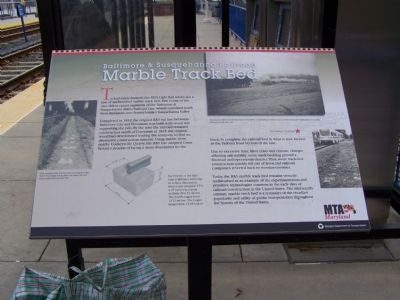
Photographed By William Pfingsten, December 22, 2007
4. Second marker at station with more detailed explanation.
Baltimore & Susquehanna Railroad Marble Track Bed
Tucked safely beneath the MTA Light Rail tracks sits a line of undisturbed marble track bed. This is one of the two oldest extant segments of the Baltimore & Susquehanna (B&S) Railroad Line, which stretched north from Baltimore into Pennsylvania's Susquehanna Valley.
Completed in 1832, the original B&S rail line between Baltimore City and Timonium was built with wood ties supporting the rails. By the time the railroad resumed construction north of Timonium in 1835, the original wood had deteriorated leading the company to find an alternative construction material. Using marble from nearby Cockeysville Quarry the B&S line adopted Great Britian's process of laying a stone foundation for the track, to complete the railroad bed in what is now known as the Padonia Road Section of the line.
Due to excessive time, labor cost and climatic changes affecting rail stability, stone track bedding proved a financial and operational disaster. Thus stone track bed construction quickly fell out of favor, and railroad companies reverted back to wooden crossties.
Today, the B&S marble track bed remains virtually undisturbed as an example of the experimentation and primitive technologies common in the early days of railroad construction in the United States. The nineteenth century marble track bed is a reminder of the steadfast popularity and utility of public transportation throughout the history of the United States.
Credits. This page was last revised on January 24, 2023. It was originally submitted on December 22, 2007, by Bill Pfingsten of Bel Air, Maryland. This page has been viewed 3,611 times since then and 38 times this year. Last updated on May 14, 2020, by Carl Gordon Moore Jr. of North East, Maryland. Photos: 1. submitted on December 22, 2007, by Bill Pfingsten of Bel Air, Maryland. 2, 3. submitted on December 31, 2022, by Adam Margolis of Mission Viejo, California. 4, 5, 6. submitted on December 22, 2007, by Bill Pfingsten of Bel Air, Maryland.
